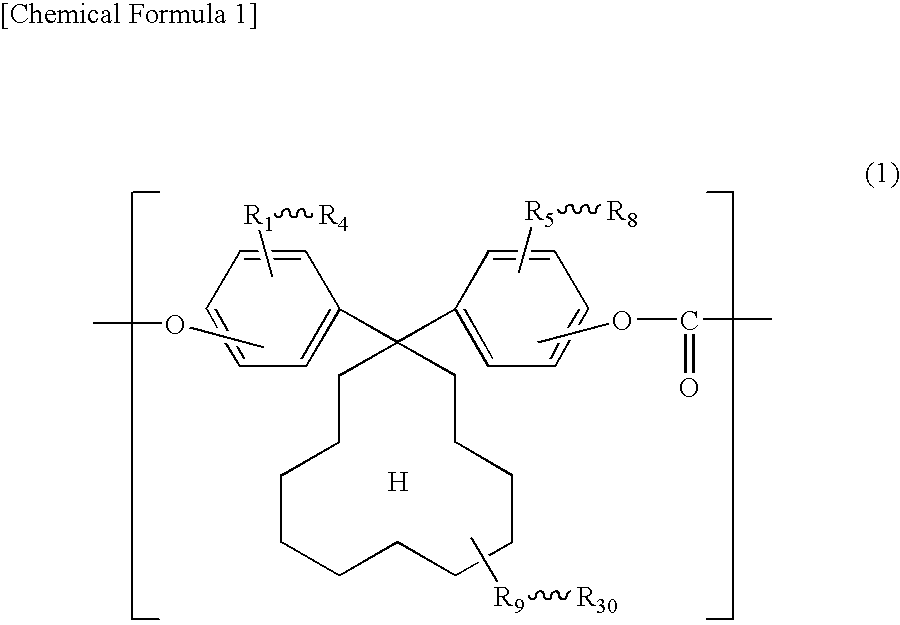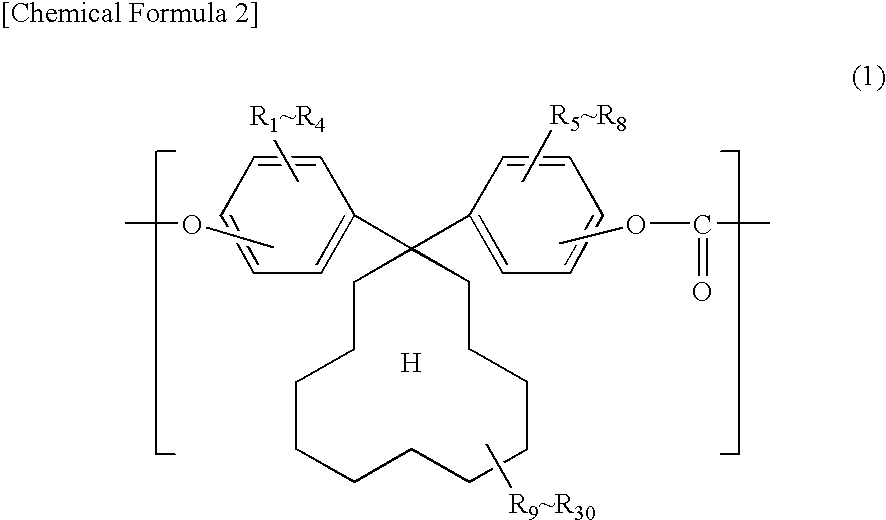Electrophotographic photosensitive body
- Summary
- Abstract
- Description
- Claims
- Application Information
AI Technical Summary
Benefits of technology
Problems solved by technology
Method used
Image
Examples
example 1
[0077]140.8 g (0.4 mol) of 1,1-bis(4-hydroxyphenyl)cyclododecane, manufactured by Taoka Chemical Co., Ltd. in Japan (hereinafter, “BPCD”), and 0.1 g of hydrosulfite were dissolved into 1100 ml of 5 w / w % aqueous solution of sodium hydroxide.
[0078]Then, 500 ml of methylene chloride was added to the aqueous solution and 60 g of phosgene was blown into the solution over a period of 60 minutes, while stirring the solution and keeping the temperature of the solution to 15° C.
[0079]After the completion of blowing phosgene in, 1.67 g of p-t-butylphenol, manufactured by Dainippon Ink And Chemicals, Inc. (hereinafter, “PTBP”), was added as a molecular weight adjuster and the solution was stirred intensely to emulsify the reaction solution. After emulsification, 0.4 ml of triethylamine was added and the emulsion was stirred at 20 to 25° C. for about an hour for polymerization.
[0080]After the completion of the polymerization, the reaction solution was separated into an aqueous phase and an org...
example 2
[0084]Synthesis was carried out in the same manner as Example 1 except that 152 g of 1,1-bis(4-hydroxy-3-methylphenyl)cyclododecane, manufactured by Taoka Chemical Co., Ltd. in Japan (hereinafter, “DMBPCD”), was used in place of BPCD and the amount of PTBP was changed to 0.82 g.
[0085]The intrinsic viscosity of the polycarbonate resin thus obtained was 0.76 dl / g. OPC was molded and performances thereof were evaluated in the same manner as Example 1 using the polycarbonate resin thus synthesized. The results were shown in Table 1.
example 3
[0086]Synthesis was carried out in the same manner as Example 1 except that the amount of BPCD was changed to 98.56 and 42.24 g of 1,1-bis(4-hydroxyphenyl)cyclohexane, manufactured by Taoka Chemical Co., Ltd. in Japan (hereinafter, “BPZ”), was used in combination with BPCD.
[0087]The intrinsic viscosity of the polycarbonate resin thus obtained was 0.52 dl / g. OPC was molded and performances thereof were evaluated in the same manner as Example 1 using the polycarbonate resin thus synthesized. The results were shown in Table 1.
PUM
| Property | Measurement | Unit |
|---|---|---|
| Percent by mass | aaaaa | aaaaa |
| Specific volume | aaaaa | aaaaa |
| Mass | aaaaa | aaaaa |
Abstract
Description
Claims
Application Information
 Login to View More
Login to View More - R&D
- Intellectual Property
- Life Sciences
- Materials
- Tech Scout
- Unparalleled Data Quality
- Higher Quality Content
- 60% Fewer Hallucinations
Browse by: Latest US Patents, China's latest patents, Technical Efficacy Thesaurus, Application Domain, Technology Topic, Popular Technical Reports.
© 2025 PatSnap. All rights reserved.Legal|Privacy policy|Modern Slavery Act Transparency Statement|Sitemap|About US| Contact US: help@patsnap.com



